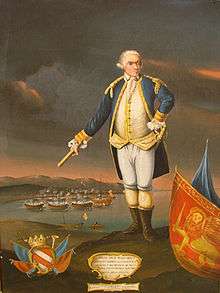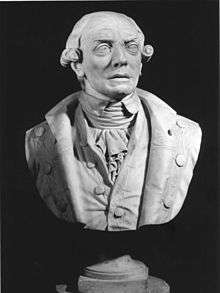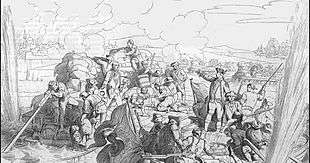Angelo Emo
Angelo Emo (3 January 1731 – 1 March 1792) was a Venetian noble and admiral, mostly known for being the last admiral of the Republic of Venice to lead the Venetian navy to battle. He attempted to introduce reforms based on the practices of the British Royal Navy, and led raids on Moorish targets along the Barbary Coast in retaliation for corsair attacks on Venetian-flagged shipping.
Angelo Emo | |
|---|---|
 | |
| Born | 3 January 1731 Venice |
| Died | 1 March 1792 (aged 61) La Valletta (aged 61) |
| Allegiance | |
| Service/ | |
| Rank | Capitano Straordinario delle Navi, Provveditore Generale da Mar |
| Battles/wars | Venetian bombardments of the Beylik of Tunis (1784–1788) |
Biography
Early life and career
Angelo Emo was born in Venice on 3 January 1731, to a distinguished aristocratic family.[1] His father was Giovanni di Gabriele and his mother was Lucia Lombardo.[2] He was educated at the Jesuit college in Brescia, before returning to Vencie, where which his father chose as his tutors the scholars Giovanni Battista Bilesimo, Jacopo Stellini, and Carlo Lodoli.[2][3]
In 1751 he entered service in the Venetian navy as a nobile di nave (gentleman cadet), going on his first sea voyage in the same year.[2][3] Already in 1755 he was captain of a warship, distinguishing himself in convoy escort duties against the attacks of pirates.[2][3] In 1758 he was charged to lead an expedition to the Atlantic Ocean in order to escort home Venetian merchant vessels and conclude a new trade agreement with Portugal. During this mission he encountered a tempest that lasted for two months and confined his ship, the San Carlo, to the coasts; during this storm he narrowly escaped shipwreck and gave proof of his seamanship and command skills, earning universal acclaim on his return to Venice in August 1759.[2][4][lower-alpha 1]
Rise to high command and state offices

In 1760 he was Provvedditore della Sanità (health commissioner), but in the next year he was commander of a squadron of one ship of the line and two frigates, sent against the Barbary pirates praying on Venetian shipping.[3] Until 1767 he alternated between anti-piracy commands and public office in Venice.[3] As Savio ed Esecutore alle Acque (water commissioner) in 1761–62, he commissioned a plan of the Venetian Lagoon, which was completed in six months.[2][3] In 1763 he was elected to the higher command rank of Patron delle Navi (rear admiral of the sailing fleet) and patrolled the Adriatic Sea.[2][6] In 1765 he was promoted to Almirante (vice admiral of the sailing fleet),[6] and in 1767–68 he forced the Dey of Algiers to conclude a favourable peace treaty with the Republic of Venice.[2][3] During this campaign, he again narrowly escaped shipwreck due to a storm aboard the 74-gun ship Ercole.[6]
On 12 June 1768, he was raised to Capitano delle Navi, full admiral of the sailing fleet.[2] When the Russian fleet under Alexei Orlov arrived in the Mediterranean in 1770 as part of the Russo-Turkish War of 1768–1774, Emo led a Venetian squadron to a cruise in the Aegean, to protect Venetian and French subjects and commercial interests in the area.[3] The conflict also saw raids by the Dulcigno pirates, ostensibly acting as subjects of the Sultan, in the Venetian Ionian Islands. Emo sailed against them, but his fleet suffered heavy losses when it was caught by a storm near Cape Matapan on 19 December 1771: half his squadron, the 74-gun ship Corriera and the frigate Tolleranza, foundered, the former with almost all hands; Emo's own flagship, the Ercole, only survived by cutting her masts.[6]
In 1772 he departed his naval duties and entered the Venetian Senate.[3] Elected several times as censor, he worked to revive the manufacture of Murano glass.[2] In 1776–1778, as a Savio alle Acque, he was responsible for several maintenance works around the Lagoon, on the Brenta River, the Terraglio road, and the canal of Cava.[2] On 18 July 1778 Emo was again elected Capitano delle Navi, hoisting his flag on the heavy frigate Sirena, to deal with the provocations of the Pashalik of Tripolitania, which tried to exploit the "right of earch" accorded to them by treaty on Venetian shipping beyond the agreed-upon limits. Emo led his fleet in a demonstration of force in front of Tripoli, forcing the pasha to conclude a new peace agreement with the Republic.[2][6] Emo's appointment was renewed for the year after, but no actions took place.[6] In 1779 he was a Savio alla Mercanzia (trade commissioner) he promoted reforms such as the reduction of tax on silk, the opening of new shops at Sebenico, and the transfer of the Venetian consulate in Egypt from Cairo to the port city of Alexandria.[2]
In 1780 he was a Provveditore ai Beni Inculti (commissioner on uncultivated lands) and laid out plans for the draining of the Adige marshlands around Verona, a project begun already by Zaccaria Betti. However, once again due to lack of funds, the plans were not carried out.[2][3] In 1782–1784 he served as director of the Venetian Arsenal (Inquisitore all'Arsenale), which he restored and reformed, beginning construction of new models of ships, imported from England and France, introducing copper sheathing, improved the methods for the manufacture of hawsers and rigging, and increased the salaries of non-noble officers.[2][3] In 1783 he led the negotiations with the Habsburg envoy Ludwig von Cobenzl on freedom of navigation in Istria and Dalmatia.[3]
High command against Tunis and death

On 6 March 1784 he was elected as Capitano Straordinario delle Navi (commander-in-chief of the sailing fleet) against the Beylik of Tunis, which had declared war on the Republic after a Venetian ship laden with goods from the Barbary coast was burned by the authorities in Malta due to it being infected with the plague.[2][7] On 21 June, Emo sailed from Venice for Corfu at the head of a squadron composed of the ships of the line Fama, Forza, and Palma, the frigates Concordia, Sirena, Brillante, Pallade, and Venere, the xebec Triton, the bombards Distruzione and Polonia, the galiot Esploratore, and the hospital ship Kav. Angelo. The fleet was soon joined by the ship of the line Concordia and the xebecs Cupido and Nettuno, but left Triton behind when it sailed for Tunisia on 12 August.[7][8]
On 1 September 1784, his squadron anchored at Cap Carthage, five miles from Tunis.[3][8] In a series of expeditions over the next three years, he repeatedly bombarded Sousse (5 October 1784, for three nights in April 1785, and in 26 September–6 October 1787), Biserte (30 May to 10 August 1787), Sfax (15–17 August 1785, and 6, 18, and 22 March 30 April and 4 May 1786), and La Goulette (on 1, 3, 5, 9 October 1758), where he utilized floating batteries of his own invention. These operations not only caused great damage and casualties in these cities, but also confined the Tunisian fleet to its harbours.[2][3][9] The Senate rejected his requests of a 10,000-man expeditionary force with which to assault and capture Tunis, however.[9] Instead, in 1787, the Bey of Tunis was forced to sign a treaty with the Republic of Venice,[3] granting it favourable trade terms: the tax rate for goods carried on Venetian merchant ships fell from 7% to 4%, although for its part the Republic was obliged to pay a lump sum of 40,000 sequins.[2] In the meantime, on 28 May 1786, Emo had been elected Procuratore de Ultra of St Mark's Basilica.[2]
The treaty did not last long, however, before the Tunisians resumed their raids. Emo led a squadron to the Aegean against them, but lost two ships in a storm. The government of the Republic confiscated his possessions to repay the lost ships.[10] In late 1790, the Senate named him Provveditore Generale da Mar,[11] but did not entrust him with leading the fleet against the Tunisian coast. With the French Revolution under way in Europe, the Senate was loath to become embroiled in a prolonged conflict, and preferred peace. The Senate feared that Emo's aggressive nature would hamper these efforts, and instead placed the Almirante Tommaso Condulmer, promoted to Capitano delle Navi, in charge of the naval blockade and the peace negotiations.[12] While waiting to join with the rest of the fleet at Malta,[2] Emo died on 1 March 1792, reportedly from a bilious attack after learning that a peace, mostly disadvantageous to Venice, had been concluded with Tunis without his being consulted.[11]
Celebrated as a great naval hero, his body was embalmed and carried to Venice on board his flagship, the ship of the line Fama.[2][11] The sculptor Antonio Canova was charged with erecting a monument to Emo. Completed in 1794, it is in the second armoury of the Venetian Arsenal. Canova was honoured by the Republic with a medal for this monument, the last such medal issued by the Republic before its end.[13] His funeral took place at St Mark's on 17 April, and he was buried at the church of Santa Maria dei Servi.[2] A funerary monument was erected over his tomb by Canova's teacher, Giovanni Ferrari, initially at Santa Maria dei Servi, then moved to San Martino, and finally, from 1817, to San Biagio.[14]
Legacy
Following the death of his older brother, Alviso Emo, in 1790, Angelo Emo's death also meant the end of the San Simeon Piccolo branch of the Emo family.[13]
Already at the time of his death, his loss was seen as a heavy blow and symptom of the Republic's decline.[2] Emo's reputation was enhanced further by 19th-century historians of Venice, keen on romanticizing the final decades of the Republic: Girolamo Dandolo calls him "the last roar issued by the Lion of St. Mark on the sea", while for Samuele Romanin he might have been able to "shake [the Republic] from the disastrous abandonment" and "inspire in her the strength and energy" that she sorely lacked in the final years of its existence. For Romanin, Emo was the last of the great captains of the Venetian navy, and indeed of the Republic, which "may indeed be said to have herself descended with him into the sepulchre".[2] After him, the Venetian navy would no longer be called upon to fight.[11]
His sudden death also led to rumours that he had been poisoned.[13] Girolamo Dandolo insisted that this was the case, and identified his deputy Tommaso Condulmer, ambitious not only to succeed him, but also to conclude a peace treaty with the Barbary states. This has been convincingly disproved by modern historians.[2]
Footnotes
- An account of the voyage was published by R. C. Anderson in The Mariner's Mirror[5]
References
- von Wurzbach 1858, pp. 35–36.
- Preto 1993.
- von Wurzbach 1858, p. 36.
- Anderson 1952, pp. 308–309.
- Anderson 1946, pp. 50–54.
- Anderson 1952, p. 309.
- Mocenigo 1935, p. 358.
- Anderson 1952, p. 310.
- Mocenigo 1935, p. 359.
- von Wurzbach 1858, pp. 36–37.
- Mocenigo 1935, p. 360.
- Mocenigo 1935, pp. 359–360.
- von Wurzbach 1858, p. 37.
- von Wurzbach 1858, pp. 37–38.
Bibliography
- Anderson, R. C. (1946). "The Unfortunate Voyage of the San Carlo". The Mariner's Mirror. 32 (1): 50–54. doi:10.1080/00253359.1946.10657418.CS1 maint: ref=harv (link)
- Anderson, R. C. (1952). Naval wars in the Levant 1559–1853. Princeton: Princeton University Press. hdl:2027/mdp.39015005292860.CS1 maint: ref=harv (link)
- Mocenigo, Mario Nani (1935). Storia della marina veneziana: da Lepanto alla caduta della Repubblica [History of the Venetian navy: from Lepanto to the fall of the Republic] (in Italian). Rome: Tipo lit. Ministero della Marina - Uff. Gabinetto.CS1 maint: ref=harv (link) pp. 358–360
- Preto, Paolo (1993). "EMO, Angelo". Dizionario Biografico degli Italiani, Volume 42: Dugoni–Enza (in Italian). Rome: Istituto dell'Enciclopedia Italiana.
- Sanfelice di Monteforte, Ferdinando (2011). "Angelo Emo, l'ultimo ammiraglio della Serenissima" (PDF). Le armi di San Marco: Atti del Convegno di Venezia e Verona, 29-30 settembre 2011. La potenza militare veneziana dalla Serenissima al Risorgimento (in Italian). Società Italiana di Storia Militare. pp. 111–122.CS1 maint: ref=harv (link)
- von Wurzbach, Constantin (1858). . Biographisches Lexikon des Kaiserthums Oesterreich. 4. Vienna. pp. 35–38.CS1 maint: ref=harv (link)
- Zampieri, Francesco (2011). "Angelo Emo e la riforma della marina veneziana" (PDF). Le armi di San Marco: Atti del Convegno di Venezia e Verona, 29-30 settembre 2011. La potenza militare veneziana dalla Serenissima al Risorgimento (in Italian). Società Italiana di Storia Militare. pp. 123–154.CS1 maint: ref=harv (link)
